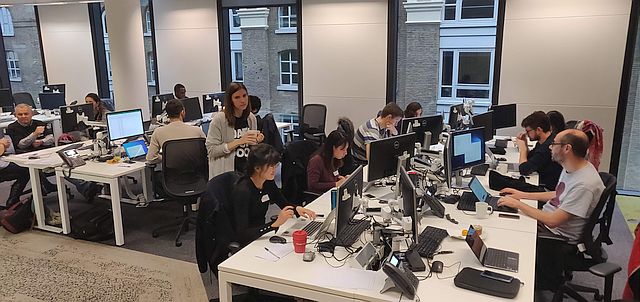Our data dive was organised by the UK chapter of DataKind which matches data experts with charities and NGOs looking to become more data-driven. On the weekend in question, the data analysts, architects and coders — who normally work for banks, insurance companies and universities — could choose between Solidaridad and health charity, the Anthony Nolan Trust.

Our volunteers in action
Some 20 people chose to work on our challenge: how Solidaridad was addressing climate adaptation. Did adaptations lead to measurable results? If so, which ones delivered the best results? And to whom? We wanted to find out if we could tailor interventions to specific target groups and how to make our new Climate Change Adaptation Indicator as robust as possible.
Data sets from six countries and five sectors
To prepare for the challenge we had mobilized our network colleagues and brought in data sets from India, Tanzania, Uganda, Kenya, Brazil and Nicaragua on sugarcane, cotton, coffee, palm oil and cocoa.
The volunteers included three data ambassadors and a troubleshooter to standardize the processes and verify the results. Before the dive could get started, they asked us to redefine our core questions more clearly and to format our data in such a way that no time would be lost during the weekend. We also had to prepare presentations, pitches and warm-up questions.
Crunchers’ questions
So, on a typically foggy autumn Saturday, our volunteers started crunching the data. Progress was slow and there were questions on issues like why sugarcane in India was irrigated and not in Brazil. Our answers frequently led to still more questions from the data experts.
The ambassadors managed to keep everyone’s spirits up by ordering pizzas before the last rush of the day brought yet another series of correlations, clusters, principal components and optimizations.
The volunteers for the two challenges (photo by DataKindUK)
We were thrown out by security at 10 pm, but the next morning everyone was back. Now it was time for presentations and the volunteers put the finishing touches to charts, tables and strings of code. Our core questions around climate adaptation were answered from no less than five different perspectives.
We now have a methodology for measuring and comparing climate adaptation practices”
The results
Thanks to the data dive:
-
we have a methodology for measuring and comparing climate adaptation practices
-
we know how to build our Climate Change Adaptation Indicator
-
we can see which techniques are useful to deepen our learning from it
-
we can improve our survey design to increase the response rate and gather more data
Correlation between adaptation and mitigation score for our sugarcane project in India
More lessons learned
Clearly, data can help us take big strides. It provides answers to complex questions and harbours some unexpected lessons like the importance of identifying the opportunity in order to be more efficient in gathering data or improving the distribution of the control group among the target population.
Moving forward, improved survey design and better data hygiene will increase efficiency and enable cross-country comparisons. And engaging local and world experts in a community of practice will help consolidate and balance our modelling while ensuring the outcomes are relevant for local practice.
